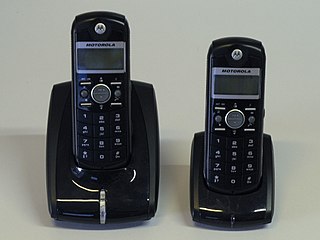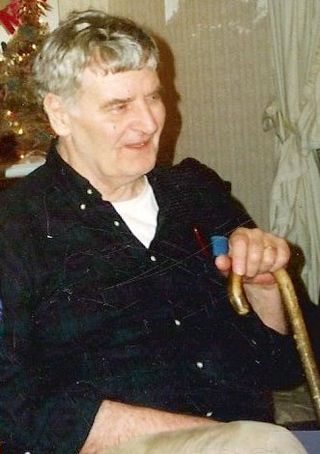
Digital Enhanced Cordless Telecommunications (DECT) is a cordless telephony standard maintained by ETSI. It originated in Europe, where it is the common standard, replacing earlier standards, such as CT1 and CT2. Since the DECT-2020 standard, it also includes IoT communication.

A telephone is a telecommunications device that permits two or more users to conduct a conversation when they are too far apart to be easily heard directly. A telephone converts sound, typically and most efficiently the human voice, into electronic signals that are transmitted via cables and other communication channels to another telephone which reproduces the sound to the receiving user. The term is derived from Greek: τῆλε and φωνή, together meaning distant voice. A common short form of the term is phone, which came into use early in the telephone's history.
In radio communication, a transceiver is an electronic device which is a combination of a radio transmitter and a receiver, hence the name. It can both transmit and receive radio waves using an antenna, for communication purposes. These two related functions are often combined in a single device to reduce manufacturing costs. The term is also used for other devices which can both transmit and receive through a communications channel, such as optical transceivers which transmit and receive light in optical fiber systems, and bus transceivers which transmit and receive digital data in computer data buses.

Ultra high frequency (UHF) is the ITU designation for radio frequencies in the range between 300 megahertz (MHz) and 3 gigahertz (GHz), also known as the decimetre band as the wavelengths range from one meter to one tenth of a meter. Radio waves with frequencies above the UHF band fall into the super-high frequency (SHF) or microwave frequency range. Lower frequency signals fall into the VHF or lower bands. UHF radio waves propagate mainly by line of sight; they are blocked by hills and large buildings although the transmission through building walls is strong enough for indoor reception. They are used for television broadcasting, cell phones, satellite communication including GPS, personal radio services including Wi-Fi and Bluetooth, walkie-talkies, cordless phones, satellite phones, and numerous other applications.

Wireless communication is the transfer of information (telecommunication) between two or more points without the use of an electrical conductor, optical fiber or other continuous guided medium for the transfer. The most common wireless technologies use radio waves. With radio waves, intended distances can be short, such as a few meters for Bluetooth or as far as millions of kilometers for deep-space radio communications. It encompasses various types of fixed, mobile, and portable applications, including two-way radios, cellular telephones, personal digital assistants (PDAs), and wireless networking. Other examples of applications of radio wireless technology include GPS units, garage door openers, wireless computer mouse, keyboards and headsets, headphones, radio receivers, satellite television, broadcast television and cordless telephones. Somewhat less common methods of achieving wireless communications involve other electromagnetic phenomena, such as light and magnetic or electric fields, or the use of sound.

A cordless telephone or portable telephone has a portable telephone handset that connects by radio to a base station connected to the public telephone network. The operational range is limited, usually to the same building or within some short distance from the base station.
A microcell is a cell in a mobile phone network served by a low power cellular base station (tower), covering a limited area such as a mall, a hotel, or a transportation hub. A microcell is usually larger than a picocell, though the distinction is not always clear. A microcell uses power control to limit the radius of its coverage area.
VTech Holdings Limited is a Hong Kong-based global supplier of electronic learning products from infancy to preschool, and the world's largest manufacturer of cordless phones.

A handset is a component of a telephone that a user holds to the ear and mouth to receive audio through the receiver and speak to the remote party using the built-in transmitter. In earlier telephones, the transmitter was mounted directly on the telephone itself, which was attached to a wall at a convenient height or placed on a desk or table. Until the advent of the cordless telephone, the handset was usually wired to the base unit, typically by a flexible tinsel wire cord.
Uniden Holdings Corporation is a Japanese company in the wireless communication industry.
Mobile VoIP or simply mVoIP is an extension of mobility to a voice over IP network. Two types of communication are generally supported: cordless telephones using DECT or PCS protocols for short range or campus communications where all base stations are linked into the same LAN, and wider area communications using 3G or 4G protocols.

George H. Sweigert (1920–1999) is credited as the first inventor to patent the cordless telephone.
The Microsoft Cordless Phone System is a discontinued cordless telephone introduced by Microsoft in 1998 that featured personal computer integration. It was Microsoft's first telephone of any kind, and the only phone product made by the company until the Windows Mobile series of smartphones.
CT1 stands for Cordless telephone generation 1 and is an analog cordless telephone standard that was standardized by the European Conference of Postal and Telecommunications Administrations (CEPT) in 1984 and deployed in eleven European countries. The initial set of frequencies provided for a set 40 duplex channels using 25 kHz separation, with the phones transmitting in the 914-915 MHz band and the base stations in the 959-960 MHz band. These frequencies overlap with those used by channels 120-124 on GSM cellular phones and thus these original frequencies have been withdrawn from use for cordless phones in the countries that originally authorized them.
CT2 is a cordless telephony standard that was used in the early 1990s to provide short-range proto-mobile phone service in some countries in Europe and in Hong Kong. It is considered the precursor to the more successful DECT system. CT2 was also referred to by its marketing name, Telepoint.
Microsoft Corporation has been selling branded hardware since 1980, and developing devices in-house since 1982, when the Microsoft Hardware division was formed to design a computer mouse for use with Microsoft Word for DOS. Since then, Microsoft has developed computer hardware, gaming hardware and mobile hardware. It also produced drivers and other software for integrating the hardware with Microsoft Windows.
Wireless telephone may refer to:

A headset is a combination of headphone and microphone. Headsets connect over a telephone or to a computer, allowing the user to speak and listen while keeping both hands free. They are commonly used in customer service and technical support centers, where employees can converse with customers while typing information into a computer. They are also common among computer gamers and let them talk with each other and hear others while using their keyboards and mice to play the game.
Gigaset AG, formerly known as Siemens Home and Office Communication Devices, is a German multinational corporation based in Bocholt, Germany. More active in the area of communications technology, it manufactures DECT telephones.

DSP Group, Inc. was an American company that manufactured chipsets for VoIP, multimedia, and digital cordless applications. Founded in 1987 with headquarters in San Jose, California, DSP Group employed over 400 people at three US sites and offices in Germany, Scotland, Israel, India, Hong Kong and Japan until it was acquired by Synaptics.








